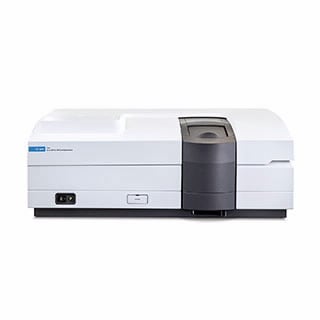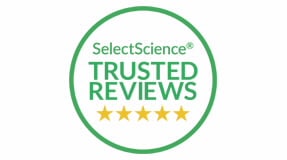
Cary 6000i UV-Vis-NIR spectrophotometer
Cary 6000i UV-Vis-NIR Spectrophotometer
The superior sensitivity of the narrow-band InGaAs detector is optimally harnessed by preferencing the spectrophotometer’s optical throughput in the SWIR region. Its 600 lines-per-mm NIR diffraction grating, blazed at 1000 nm, concentrates optical dispersion into the 800–1800 nm region, eliminating wasted photons that would otherwise fall beyond the range of the detector. The Cary 6000i is your ultimate tool for materials characterization spectroscopy.
Using Cary WinUV software with the Cary 6000i makes it easy to perform powerful analysis and control optional accessories. The large sample compartment can be expanded to hold large accessories and integrating spheres for spectral and diffuse reflectance. The LockDown mechanism makes it possible to quickly change and position accessories for reproducible results.
- UV-Vis & UV-Vis-NIR Instruments
Request a Quote
Product Details
- Measure beyond 8.0 absorbance units with reference beam attenuation.
- Measure 175 to 1800 nm using a narrow-band InGaAs detector and 600 l/mm NIR diffraction gratings for unmatched sensitivity in the short-wave infrared.
- Cary WinUV software—modular software with powerful analysis and enhanced transfer and report export capabilities.
- Versatile set of accessories for materials characterization spectroscopy, including spectral and diffuse reflectance.
- Variable slit widths (down to 0.01 nm) for optimum control over data resolution.
- Large sample compartment with LockDown mechanism for quick accessory changes and reproducible results.
- Maximum light throughput using Schwarzchild source coupling optics and optimized grating blaze wavelength for higher accuracy at low transmission levels.
- Minimal noise and stray light using a floating aluminum casting and double out-of-plane Littrow monochromator.
- Extended dynamic range by attenuating the reference beam to balance double beam signal levels.
- Nitrogen purging—separate purging in the sample and monochromator compartments to reduce oxygen and water vapor in the ultra-violet.
| Control Software |
|
| Depth |
|
| Height |
|
| Light Source |
|
| Maximum Scanning Speed |
|
| Photometric Range (Abs) |
|
| Photometric System |
|
| Power Requirements |
|
| Spectral Bandwidth |
|
| Wavelength |
|
| Weight |
|
| Width |
|
| Z-height |
|
Double Beam Spectrophotometers
Double beam spectrophotometers are fast and accurate, using two beams of light—a sample beam and a reference beam—to correct instrument fluctuations in real-time.
Learn More- Key Literature
-
Cary 4000/5000/6000i Series UV-Vis-NIR Spectrophotometers Brochure
The Cary 4000/5000/6000i Series UV-Vis-NIR spectrophotometers are unrivaled, precise and flexible, and are designed to meet your application requirements
- Brochures
- English
- 13 Jul 2022
- 9.23 MB
Comparing the Limiting Resolution of the Cary 5000 and Cary 6000i UV-Vis-NIR Spectrophotometers Using the Transmission Spectrum of Water Vapor
Application note for comparing the limiting resolution of the Cary 5000 and Cary 6000i UV-Vis-NIR spectrophotometers using the transmission spectrum of water vapor
- Application Notes
- English
- 06 Feb 2014
- 150.51 KB
Accessories for Agilent Cary UV‑Vis‑NIR Spectrophotometers
This accessory selection guide helps you tailor your UV-Vis-NIR setup to match your application needs.
- Selection Guides
- English
- 03 Nov 2025
- 1.74 MB
- Application Notes
- Brochures
- Catalogs
- Data Sheets
- Flyers
- Posters
- Primers
- Selection Guides
- Technical Overviews
- White Papers
- FAQs
-
FAQ: Cary Win UV cool tricks on Graphics Windows
On most applications, there are some things we can do to make the graphics window look different and sometimes easier to read. This information relates to the use of the SCAN Application, but can also apply to other applications.
FAQ: How to Run Cary UV/Vis Instrument Performance Tests
When necessary, the operator of a Cary UV/Visible instrument can perform tests to access the performance of the instrument and software. The following steps outline execution of these performance tests.
Why Do We Perform a Zero and Baseline in Scan?
The purpose for zeroing is to balance both the reference beam and the sample beam. By adjusting to zero, the instrument readings reflect the absence of sample.
Why is My Cary Spectrophotometer Failing Initialization or Making a Screeching Noise?
Why is My Cary Spectrophotometer Failing Initialization or Making a Screeching Noise?
How Do I Perform a Cary 6x6 Method in Advanced Reads?
How Do I Perform a Cary 6x6 Method in Advanced Reads?
UV-Vis-NIR Overview & Principles
Learn about the main principles of UV-Vis-NIR spectroscopy, including how UV-Vis-NIR spectrophotometers work, the strengths and limitations of the technique, plus applications, and UV-Vis-NIR measurement techniques.
- Instruction Sheets
- Site Preparation Checklists
- Supplemental Information
- User Manuals
More help is just a click away
If you didn't find what you need, try these resources or contact a specialist
New Accessory Guide for Agilent Cary UV-Vis/NIR Spectrophotometers
This selection guide provides a high-level overview of the popular accessories for Cary 4567’000 spectrophotometers, to answer the question “what else can your instrument do?” The guide captures common queries relating to sample type, analytical requirements, and measurement mode. The guide is categorized into solid, liquid, and miscellaneous sections, with quick-reference tables to facilitate comparisons between measurement options.
- 24 Nov 2025
New Software Trilogy for Cary 4/5/6/7000 UV-Vis/NIR Spectrophotometers
Three new versions of software have been released for use with the Cary 4/5/6/7000 UV-Vis-NIR spectrophotometers. Cary WinUV Software (v6.6) is used to control the instruments, perform calculations, and create reports. Color Software (v6.5) performs calculations and produces reports against the internationally recognized color standards including CIE. AutoPro (v7.0) software is used with the Solids Autosampler for performing automated multi-sample analysis, or sample mapping.
- 13 May 2025
New Cary WinUV Color Software for Cary 4/5/6/7000 UV-Vis/NIR Spectrophotometers
A new version of Cary WinUV Color Software (v6.5) has been released for the Cary 4/5/6/7000 UV-Vis/NIR Spectrophotometers. This Color Software is suitable for Cary 4/5/6/7000 UV-Vis/NIR systems running on the Cary WinUV v6.5 software, or the recently released Cary WinUV v6.6 software.
- 01 Apr 2025
Read reviews on the Cary 6000i UV-Vis-NIR Spectrophotometer
Explore customer reviews posted on SelectScience, or write your own review.
UV-Vis & UV-Vis-NIR Instrument Selection Guide
Find out which Agilent UV-Vis or UV-Vis-NIR spectrophotometer is best for your needs.
UV-Vis-NIR Solid Sample Measurement Accessories Guide
Learn about key solid sample accessories for Cary 4000, 5000, 6000i, and 7000 spectrophotometers.
UV-Vis Spectrophotometer Applications Overview
A guide to modern UV-Vis spectrophotometer uses, measurement techniques, and their applications.
UV-Vis Spectroscopy Learning Tools
Get your Basics of UV-Vis Spectrophotometry handbook, and a pack of four undergraduate teaching lab experiments.
Videos
- Publications
-
- Highly performant nanocomposite cryogels for multicomponent oily wastewater filtration, Lía Vásquez, Katarzyna Dziza, Siew-Leng Loo, Vassilios Binas, Sofia Stefa, George Kiriakidis, Athanassia Athanassiou, Despina Fragouli. Separation and Purification Technology, Volume 303, 15 December 2022, 122252 Learn More
- Surface-enhanced Raman spectroscopy chips based on silver coated gold nanostars, Miriam Parmigiani, Benedetta Albini, Giovanni Pellegrini, Marco Genovesi, Lorenzo De Vita, Piersandro Pallavicini, Giacomo Dacarro, Pietro Galinetto, Angelo Taglietti. Nanomaterials 2022, 12 (20), 3609 Learn More
- Recovery of cobalt from lithium-ion battery cathode material by combining solvoleaching and solvent extraction, Nand Peeters, Koen Binnemans, Sofía Riaño, Green Chem., 2022, 24, 2839-2852 Learn More




